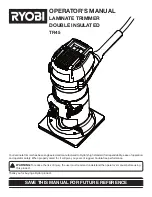
27
GB
that the angle of the cutting edge is not altered in the
process. File in one direction only.
Replacing and resharpening the cutting blade at the
end of the mowing season always resharpen the cutting
blade or, if required, replace the cutting blade with a new
one.
Unbalanced blades will cause the brush cutter to vibrate
violently-risk of accident!
Change and clean the spark plug Fig. 35
1. Once the engine has cooled, remove the spark plug
using the socket spanner supplied.
2. Clean the plug with a wire brush.
3. Using a feeler gauge; set the gap to 0.5-0.7 mm.
4. Install the spark plug carefully by hand, to avoid cross-
threading.
5. After the spark plug is seated, tighten with spanner to
compress the washer.
Clean the air filter Fig. 36
Soiled air filters reduce the engine power by supplying
too little air to the carburetor. Regular checks are
therefore essential.
•
Unclip the air filter cover and remove the sponge filter
element.
• To avoid objects falling into the air tank, replace the air
filter cover.
•
Wash the filter element in warm soap water, rinse and
allow drying naturally.
Important:
Never clean the air filter with petrol or
inflammable solvents.
m
Warning!
Never run the engine without the air filter element
installed.
Lubricate angle transmission Fig. 37
Lubricate with lithium-based grease. Remove the screw
(A) and put in the grease, turning the shaft manually until
grease emerges, then replace the screw (A).
Storing the unit
After cutting, clean the unit thoroughly. Store the unit in a
dry room allow the motor to cool down beforehand.
Important hint in case of sending the equipment to a
service station:
Due to security reasons please see to it that the
equipment is sent back free of oil and gas!
11. Storage
Cleaning
• Keep handles free of oil, so you always have a secure
hold.
• Clean the equipment as required with a damp cloth
and, if necessary, mild washing up liquid.
m
Important!
• Always pull out the spark boot plug each time before
carrying out any cleaning.
• Never immerse the equipment in water or other liquids
in order to clean it.
• Store the chainsaw in a safe and dry place out of the
reach of children.
Storage
Important: Never put the equipment into storage for
longer than 30 days without carrying out the following
steps.
Storing the equipment
If you intend to store the equipment for longer than 30
days, the equipment must be prepared accordingly.
Otherwise the fuel still remaining in the carburetor will
evaporate and leave a rubbery sediment. This can cau-
se problems when starting up the equipment and may
require expensive repairs.
1
Slowly remove the fuel tank cap to release any pres-
sure that may have formed in the tank. Carefully empty
the tank.
2
To remove the fuel from the carburetor, start the engine
and let it run until the equipment stops.
3
Leave the engine to cool (approx. 5 minutes).
4
Remove the spark plug (see section 10 Change and
clean the spark plug).
5
Add one teaspoon of 2-stroke engine oil into the com-
bustion chamber. Slowly pull the starter cord several
times to apply a layer of oil to all internal components.
Fit the spark plug again.
Note:
Store the equipment in a dry place and far away
from possible ignition sources such as an oven, a gas-fi
red hot water boiler, a gas-fi red dryer, etc.
Putting the equipment back into operation
1
Remove the spark plug (see section 10 Change and
clean the spark plug).
2
Quickly tug on the starter cord to remove excess oil
from the combustion chamber.
3
Clean the spark plug and check that the electrode gap
is correct, or insert a new spark plug with the correct
electrode gap.
4
Prepare the equipment for operation.
5
Fill the tank with the relevant mixture of fuel and oil.
See the section „Fuel and oil“.
Transport
To transport the machine, empty the petrol tank as
described in section 8 draining fuel. Clean coarse dirt off
the equipment with a brush or hand brush.
12. Disposal and recycling
The equipment is supplied in packaging to prevent it
from being damaged in transit. The raw materials in
this packaging can be reused or recycled. The equip-
ment and its accessories are made of various types of
material, such as metal and plastic. Defective compo-
nents must be disposed of as special waste. Ask your
dealer or your local council.
Summary of Contents for 5910703903
Page 2: ......
Page 4: ...8 9 10 11 12 13 14 15 16 17 ...
Page 5: ...19 20 21 26 23 24 25 27 22 18 ...
Page 6: ...28 29 30 31 32 33 34 0 5 mm 35 36 1 37 A ...
Page 7: ...120 mm 4 75 in Ø 2 4 mm 2 x 3 0 m 118 in 38 39 41 43 44 40 42 ...
Page 40: ...40 Ersatzteilzeichnung Spare parts drawing Pièces détachées dessin 22 6 2 26 ...
Page 41: ...41 22 6 6 6 6 ...
Page 43: ...43 ...
















































